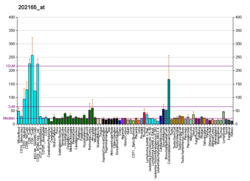PPP1R2
Protein-coding gene in the species Homo sapiens
| PPP1R2 | |||||||||||||||||||||||||||||||||||||||||||||||||||
|---|---|---|---|---|---|---|---|---|---|---|---|---|---|---|---|---|---|---|---|---|---|---|---|---|---|---|---|---|---|---|---|---|---|---|---|---|---|---|---|---|---|---|---|---|---|---|---|---|---|---|---|
| |||||||||||||||||||||||||||||||||||||||||||||||||||
| Identifiers | |||||||||||||||||||||||||||||||||||||||||||||||||||
| Aliases | PPP1R2, IPP-2, IPP2, protein phosphatase 1 regulatory inhibitor subunit 2, PPP1R2A | ||||||||||||||||||||||||||||||||||||||||||||||||||
| External IDs | OMIM: 601792; MGI: 1914099; HomoloGene: 4546; GeneCards: PPP1R2; OMA:PPP1R2 - orthologs | ||||||||||||||||||||||||||||||||||||||||||||||||||
| |||||||||||||||||||||||||||||||||||||||||||||||||||
| |||||||||||||||||||||||||||||||||||||||||||||||||||
| |||||||||||||||||||||||||||||||||||||||||||||||||||
| |||||||||||||||||||||||||||||||||||||||||||||||||||
| |||||||||||||||||||||||||||||||||||||||||||||||||||
| Wikidata | |||||||||||||||||||||||||||||||||||||||||||||||||||
| |||||||||||||||||||||||||||||||||||||||||||||||||||
Protein phosphatase inhibitor 2 is an enzyme that in humans is encoded by the PPP1R2 gene.[5][6][7]
Interactions
PPP1R2 has been shown to interact with LMTK2[8] and PPP1R9B.[9]
References
- ^ a b c GRCh38: Ensembl release 89: ENSG00000184203 – Ensembl, May 2017
- ^ a b c GRCm38: Ensembl release 89: ENSMUSG00000047714 – Ensembl, May 2017
- ^ "Human PubMed Reference:". National Center for Biotechnology Information, U.S. National Library of Medicine.
- ^ "Mouse PubMed Reference:". National Center for Biotechnology Information, U.S. National Library of Medicine.
- ^ Permana PA, Mott DM (April 1997). "Genetic analysis of human type 1 protein phosphatase inhibitor 2 in insulin-resistant Pima Indians". Genomics. 41 (1): 110–4. doi:10.1006/geno.1997.4649. PMID 9126490.
- ^ Helps NR, Street AJ, Elledge SJ, Cohen PT (February 1994). "Cloning of the complete coding region for human protein phosphatase inhibitor 2 using the two hybrid system and expression of inhibitor 2 in E. coli". FEBS Letters. 340 (1–2): 93–8. doi:10.1016/0014-5793(94)80179-7. PMID 8119416. S2CID 10674654.
- ^ "Entrez Gene: PPP1R2 protein phosphatase 1, regulatory (inhibitor) subunit 2".
- ^ Wang H, Brautigan DL (December 2002). "A novel transmembrane Ser/Thr kinase complexes with protein phosphatase-1 and inhibitor-2". The Journal of Biological Chemistry. 277 (51): 49605–12. doi:10.1074/jbc.M209335200. PMID 12393858.
- ^ Terry-Lorenzo RT, Elliot E, Weiser DC, Prickett TD, Brautigan DL, Shenolikar S (November 2002). "Neurabins recruit protein phosphatase-1 and inhibitor-2 to the actin cytoskeleton". The Journal of Biological Chemistry. 277 (48): 46535–43. doi:10.1074/jbc.M206960200. PMID 12270929.
Further reading
- Sanséau P, Jackson A, Alderton RP, Beck S, Senger G, Sheer D, et al. (August 1994). "Cloning and characterization of human phosphatase inhibitor-2 (IPP-2) sequences". Mammalian Genome. 5 (8): 490–6. doi:10.1007/BF00369318. PMID 7949733. S2CID 11381670.
- Park IK, Roach P, Bondor J, Fox SP, DePaoli-Roach AA (January 1994). "Molecular mechanism of the synergistic phosphorylation of phosphatase inhibitor-2. Cloning, expression, and site-directed mutagenesis of inhibitor-2". The Journal of Biological Chemistry. 269 (2): 944–54. doi:10.1016/S0021-9258(17)42203-4. PMID 8288648.
- Kakinoki Y, Somers J, Brautigan DL (December 1997). "Multisite phosphorylation and the nuclear localization of phosphatase inhibitor 2-green fluorescent protein fusion protein during S phase of the cell growth cycle". The Journal of Biological Chemistry. 272 (51): 32308–14. doi:10.1074/jbc.272.51.32308. PMID 9405437.
- Yang J, Hurley TD, DePaoli-Roach AA (July 2000). "Interaction of inhibitor-2 with the catalytic subunit of type 1 protein phosphatase. Identification of a sequence analogous to the consensus type 1 protein phosphatase-binding motif". The Journal of Biological Chemistry. 275 (30): 22635–44. doi:10.1074/jbc.M003082200. PMID 10807923.
- Agarwal-Mawal A, Paudel HK (June 2001). "Neuronal Cdc2-like protein kinase (Cdk5/p25) is associated with protein phosphatase 1 and phosphorylates inhibitor-2". The Journal of Biological Chemistry. 276 (26): 23712–8. doi:10.1074/jbc.M010002200. PMID 11320080.
- Eto M, Elliott E, Prickett TD, Brautigan DL (November 2002). "Inhibitor-2 regulates protein phosphatase-1 complexed with NimA-related kinase to induce centrosome separation". The Journal of Biological Chemistry. 277 (46): 44013–20. doi:10.1074/jbc.M208035200. PMID 12221103.
- Terry-Lorenzo RT, Elliot E, Weiser DC, Prickett TD, Brautigan DL, Shenolikar S (November 2002). "Neurabins recruit protein phosphatase-1 and inhibitor-2 to the actin cytoskeleton". The Journal of Biological Chemistry. 277 (48): 46535–43. doi:10.1074/jbc.M206960200. PMID 12270929.
- Wang H, Brautigan DL (December 2002). "A novel transmembrane Ser/Thr kinase complexes with protein phosphatase-1 and inhibitor-2". The Journal of Biological Chemistry. 277 (51): 49605–12. doi:10.1074/jbc.M209335200. PMID 12393858.
- Gevaert K, Goethals M, Martens L, Van Damme J, Staes A, Thomas GR, Vandekerckhove J (May 2003). "Exploring proteomes and analyzing protein processing by mass spectrometric identification of sorted N-terminal peptides". Nature Biotechnology. 21 (5): 566–9. doi:10.1038/nbt810. PMID 12665801. S2CID 23783563.
- Leach C, Shenolikar S, Brautigan DL (July 2003). "Phosphorylation of phosphatase inhibitor-2 at centrosomes during mitosis". The Journal of Biological Chemistry. 278 (28): 26015–20. doi:10.1074/jbc.M300782200. PMID 12697755.
- Sakashita G, Shima H, Komatsu M, Urano T, Kikuchi A, Kikuchi K (February 2003). "Regulation of type 1 protein phosphatase/inhibitor-2 complex by glycogen synthase kinase-3beta in intact cells". Journal of Biochemistry. 133 (2): 165–71. doi:10.1093/jb/mvg020. PMID 12761178.
- Beausoleil SA, Jedrychowski M, Schwartz D, Elias JE, Villén J, Li J, et al. (August 2004). "Large-scale characterization of HeLa cell nuclear phosphoproteins". Proceedings of the National Academy of Sciences of the United States of America. 101 (33): 12130–5. Bibcode:2004PNAS..10112130B. doi:10.1073/pnas.0404720101. PMC 514446. PMID 15302935.
- Rual JF, Venkatesan K, Hao T, Hirozane-Kishikawa T, Dricot A, Li N, et al. (October 2005). "Towards a proteome-scale map of the human protein-protein interaction network". Nature. 437 (7062): 1173–8. Bibcode:2005Natur.437.1173R. doi:10.1038/nature04209. PMID 16189514. S2CID 4427026.
- Yamada M, Ikeda Y, Yano M, Yoshimura K, Nishino S, Aoyama H, et al. (June 2006). "Inhibition of protein phosphatase 1 by inhibitor-2 gene delivery ameliorates heart failure progression in genetic cardiomyopathy". FASEB Journal. 20 (8): 1197–9. doi:10.1096/fj.05-5299fje. PMID 16627625. S2CID 911020.
- King TD, Gandy JC, Bijur GN (November 2006). "The protein phosphatase-1/inhibitor-2 complex differentially regulates GSK3 dephosphorylation and increases sarcoplasmic/endoplasmic reticulum calcium ATPase 2 levels". Experimental Cell Research. 312 (18): 3693–700. doi:10.1016/j.yexcr.2006.08.010. PMC 1885546. PMID 16987514.
- Olsen JV, Blagoev B, Gnad F, Macek B, Kumar C, Mortensen P, Mann M (November 2006). "Global, in vivo, and site-specific phosphorylation dynamics in signaling networks". Cell. 127 (3): 635–48. doi:10.1016/j.cell.2006.09.026. PMID 17081983. S2CID 7827573.
- v
- t
- e

















